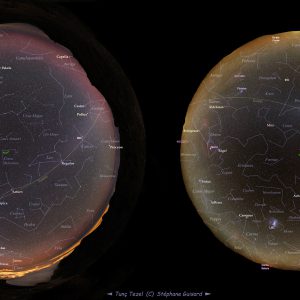Darkest Sky in Two Hemispheres
Description
These two images are unique efforts by two TWAN photographers to display an ideal naturally dark skies from both hemispheres. These two all-sky views are imaged from two of the world’s leading observatory sites. One is made in the northern hemisphere from top of La Palma in the Canary Islands (left), and another from near Cerro Paranal in Chile which was made a year earlier. Move the slider on the image to see all the labels and constellation figures. In a natural dark night, the faint glow of Zodiacal Light (sunlight reflected and forward scattered by dust in the plane of the Solar System) is detectable as a complete band across the sky, as captured here. Dark starry sky is an essential beauty of our natural environment but it is also astronomically important. Skyglow in our modern life does not allow us to see the darkest possible sky. Skyglow is caused by light pollution, and also naturally by moonlight, twilight, aurora, the zodiacal light, and in minor effects bright planets and starlight (Milky Way and individual stars), and also by airglow (very faint natural glow of our atmosphere). To achieve these images TWAN photographers chose a new Moon night (no Moon) and selected a time when the Milky Way has touched all around the horizon (visible as a circle around the horizon) with the minimum share in causing skyglow. The light around the horizon in these views is mainly from the disc of our home galaxy, the Milky Way. In such dark skies there is a faint patch of light across the sky which is the Zodiacal Band, the fainter continuation of Zodiacal Light. A slightly brighter region of the band is an oval glow of back scattered light directly opposite the Sun and known as the Gegenschein (German for “counter glow”) which might be seen with unaided-eye under very dark skies. It is clearly visible in the both views. La Palma image by Tunc Tezel and Paranal image by Stephane Guisard (May 2011 & Oct. 2010). See Guisard webpage for this pair of all-sky views.


comments (2)
its wonderful image.i really like it very much.
July 30, 2011 at 11:41 amwonderful concept!! fascinating to study – the descriptions are much appreciated.
July 30, 2011 at 2:10 pm